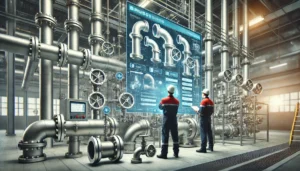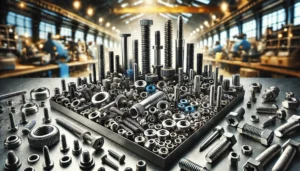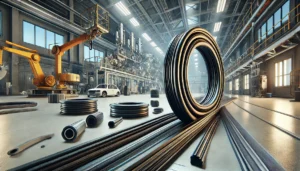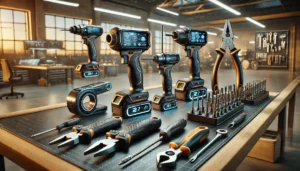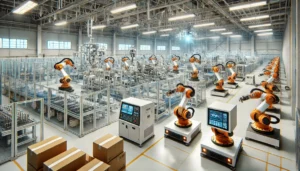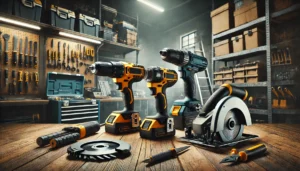The industry is going through a transformational period, where innovations are improving safety, productivity, and efficiency. Here are five advancements in industrial tools that are paving ways into the future:
1. Use of Artificial Intelligence (AI) in Industrial Tools
A variety of contemporary industrial machines today incorporate AI, allowing a computer or machine to process information and learn to make decisions independently. AI-based tools can predict breakdowns, plan production schedules, and improve quality control by examining large data sets. For example, AI enhances automation in production through functional programming of tools to streamline tool path programming, which lowers setup time and error rates. This automation significantly improves both the speed and accuracy of manufacturing processes. AI also allows for predictive maintenance, detection of potential problems before they occur, which aids in reducing the repairs needed as well as the amount of time needed. Companies that have incorporated AI have reported faster project completions and better product standards, directly improving operational efficiency.
2. Smart Tools Enabled by IoT
IoT has transformed industrial operations by linking tools and machinery to a central network that enables the exchange of real-time data. IoT enabled tools offer insights into system performance, predictive maintenance, and operational disruptions. These disruptions can be mitigated by proactive interventions that reduce equipment downtime while enhancing its lifespan. IoT sensors embedded in other industrial tools also provide energy consumption, productivity, and equipment health status. In turn, this informs manufacturers on how to allocate resources more effectively, improving workflow, and inventory management. As a result, IoT has made factories smarter and set a new benchmark for industrial operations.
3. Increased Robotics and Automation
The advancements in robotic technology has led to the emergence of modern robots capable of performing tasks with precision and adaptability. With the aid of cabot technology, teachers can work in conjunction with human workers to boost both productivity and safety. These robots use sensors and AI algorithms to move in dynamic environments and perform functions like assembly, welding, and moving materials. They have been particularly useful in environments that are repetitive or even hazardous. Advanced automation reduces human error and injuries as well as speeds up production cycles while ensuring the same quality is produced. In turn, this has made it essential in highly competitive markets.
4. Additive Manufacturing (3D Printing) Technologies
Additive manufacturing, commonly known as 3D printing, has transitioned from prototyping to full-scale production in industrial settings. This technology allows complex geometries to be produced that are challenging or impossible to achieve using conventional manufacturing techniques. It allows the use of a wide range of materials such as metals, polymers, and ceramics, making their use highly appreciated for the production of specific lightweight and customized components. For the manufacturing industry, additive manufacturing greatly minimizes material waste and lowers the cost per production unit by shortening the lead time from design to production. It has applications in aerospace, automotive and in the healthcare sector. It even boosts creativity because manufacturers are able to play with new designs and make affordable prototypes without high costs.
5. Operational Tools using Augmented Reality (AR) and Virtual Reality (VR) Technology
Industrial tools are increasingly being augmented with augmented and virtual reality software for training, maintenance, and operation. AR software can project virtual equipment which can assist skilled workers in performing complicated tasks with increased accuracy and with lesser training time. VR allows operators to perform simulated tasks through advanced immersive technology that makes it possible to gain the required experience without the consequences involved. This ensures augmenting skills, powerful safety measures, and improved productivity within the industrial environment. Currently, AR goggles are being extensively utilized for assisting remote repair as experts can direct the technician without being physically present at the location. This saves time and money that is lost due to travel and waiting for repairs to be done.
Broadening the Scope of Industrial Tools with Sustainability
Sustainability is another major reason for the innovation of industrial tools. More and more energy friendly and environmentally friendly tools are being manufactured by the construction industry. The introduction of modular components allows tools to be easily repaired or upgraded and increases the usable life of the tool and decreases waste. Not only do these practices improve the environment, but they also support increased corporate social responsibility and make the company more appealing to customers and investors.
Conclusion
Integrating AI, IoT, next generation robotics, 3D printing, and Augmented and Virtual Reality with industrial machines is a major breakthrough for the areas of manufacturing and production. These technologies accelerate processes and promote the creation of smarter and more adaptive industrial environments. On top of this, they contribute towards a more green world by enabling manufacturers to construct tools that are less harmful to the environment while using the right amount of resources. All industries must keep up with these changes to remain competitive in fast moving technological progress. The goal of purchasing these tools is to relocate the line of operations towards a future of industry that is better than today.


